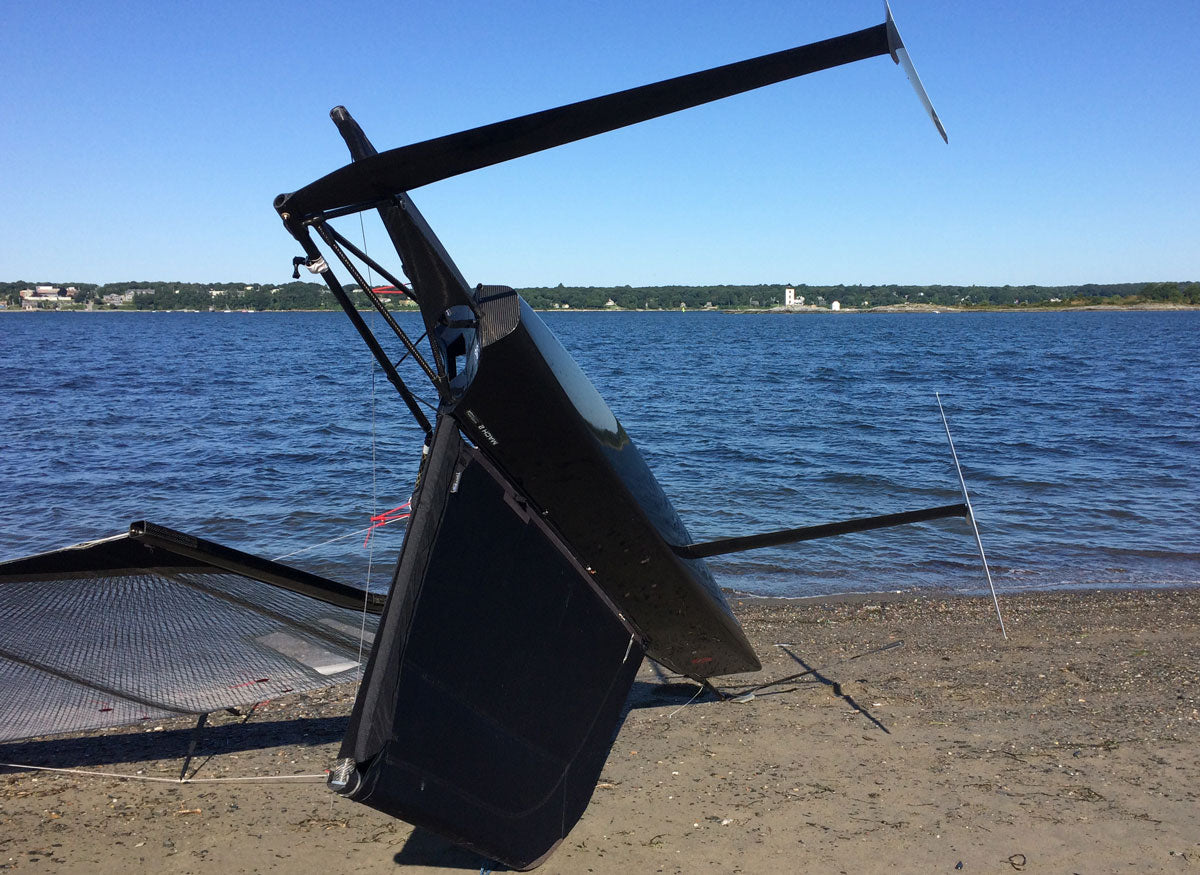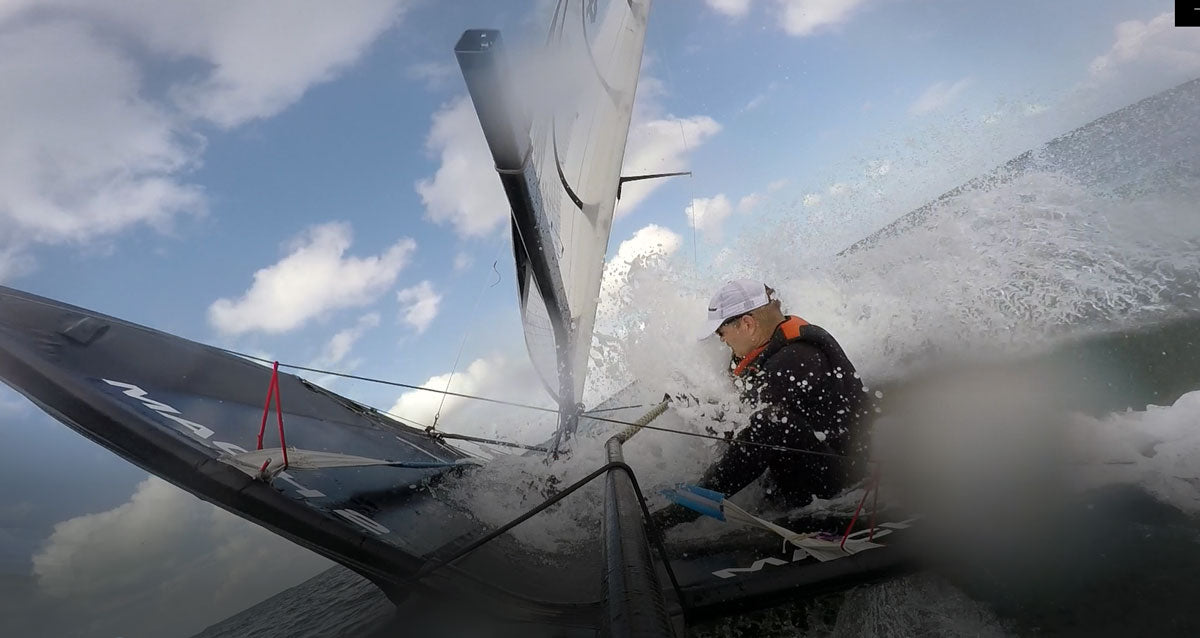NORTH SAILS BLOG
All
Events
Guides
News
People
Podcast
Sustainability
Tech & Innovation
Travel & Adventure

INTERNATIONAL MOTH TUNING GUIDE
This guide is designed to add additional support information to sailors rigging their International Moth Helix sails for the first time. There are some fundamental differences with the Helix sail, ‘twin-skin’ split batten technology, compared to previous models. The Helix sail offers a large step forward in performance, however, there are some new learnings required when rigging, which once understood, is neither complicated nor time-consuming.
Initial Set-Up
When your sail arrives the following should be included:
1. 7 x Full Length Split Battens
2. 6 x Decksweeper battens – Glass RB
3. 13 x Rocket Adjusters
4. 6 x mast cups. Numbered 1-6
These battens should be cut to length and there should be no requirement to adjust the length of them. Please contact a North Sails representative if you feel the battens need to be adjusted. Any batten length adjustment should be off the back of the batten and not from the split end.
Batten lengths may vary +/-20mm
These parts should be fitted, but if not, take the following steps:
Battens
Step 1: Batten Cups
The battens cups need to be threaded onto the webbing strap found inside the luff tube. The webbing strap prevents the cups from moving in a vertical direction whilst sailing, hence the cups grip onto the strap quite tightly.
Once the cups are threaded onto the webbing strap, pass the strap down the luff tube, ensuring to remove any twists from the strap.
The Cups may need adjusting slightly once you are rigged. Follow the impression of the batten along the batten pocket and aim to keep it aligned or fractionally on the high side of the pocket. The webbing strap may be overlength and can be cut to length – around the height of the boom. There is no requirement to locate the lower end of the strap.
Step 2: Batten insertion
Batten #1
The top batten doesn’t have a mast cup. There are however 2 batten pockets on the luff tube, one on each side. The split batten end needs to pass into each of these pockets. The batten pockets are offset so that each of the split tips can be inserted in turn. Put your hand up inside the luff tube from the zip at batten #2. Pass the tip of the #1 batten into the pockets on each side of the sail. This process can be slightly tricky but easily managed and only has to be done once.
Batten #2 - #7
These battens are to be inserted from the rear end and then the split tip is inserted into the receptacles on the rear face of the cups. There are sacrificial pieces of plastic within these receptacles that are designed to break and distort to add friction to the batten and prevent it from falling out. The batten will need to be pushed firmly into the batten cup receptacle. At batten #7 there is a batten holder on each side of the luff tube. Each half of the batten needs to be passed through these.
Add rocket batten tensioners to all battens.
Step 3: Deck Sweeper Battens
There are 6 x deck sweeper battens that can be fitted and rocket tensioners added.
The diagonal deck sweeper battens are the only battens that need removing for de-rigging and sail rolling.
Rigging
Step 1
Insert the mast into the luff tube, as per all previous models, ensuring to pass the mast above the battens and not through any of the split battens.
Note:
Avoid wrapping the mast tip around the webbing strap
At batten 7 there are batten holders on each side of the luff tube, the mast must pass in front of these.
Once the mast tip reaches batten #2, the uppermost batten cup, ensure to thread this batten cup onto the mast (pushing the mast in front of the cup). Continue to push the tip of the mast into the head of the sail.
Step 2
Shuffle the luff of the sail down the mast until you can see the forestay and spreader fittings.
KEEP ALL BATTEN CUPS OFF THE RIG AT THIS STAGE (except for Batten #2 – cup #1)
Step 3
Continue to rig the sail onto the boat. Attach the clew and boom vang. Some pre-bend will be required to attach the batten cups.
Step 4
Once there is some pre-bend, achieved by some vang load, the next step is to put the batten cups onto the rig. Work from the top down, carefully putting each cup onto the rig. Normally twisting them slightly can help to get them on. Once all the cups are on, slide the luff tube downwards and attach the cunningham.
De-Rigging
Aim to do the above procedure in reverse. Remove cups from the rig before releasing the clew. This de-loads the sail and it's far easier to remove spreaders etc.
Tuning & Race Set-Up
Battens
In general batten tension should increase from top to bottom. Aim for one or two small creases in batten #1, one crease in batten #2, half a crease in batten #3, and no creases in battens #4-7. Luff round and sail camber can be tailored with batten tension in the lower battens. Adjusting batten tension to different wind conditions will produce performance variation as the batten tension will increase camber.
Batten cups
When fully rigged with vang and cunningham loads @ 70% ensure the battens run along the batten pockets and the cups are not sitting too high or too low. Aim to have the batten and cup just high within the batten pocket.
There are a few nuances to this new design, but once understood, rigging time is very similar to previous models.
Please feel free to contact Rob Greenhalgh with any questions.
READ MORE
READ MORE

LET’S TALK MOTH WITH TOM SLINGSBY AND ROB GREENHALGH | SESSION THREE
LET’S TALK MOTH WITH TOM SLINGSBY AND ROB GREENHALGH
Session Three
Moth World Champion Tom Slingsby and North Sails class leader Rob Greenhalgh talk us through the in’s and out’s of race day strategy, and provide tuning tips for the newly released 9DSX Decksweeper mainsail in the third webinar, ‘Let’s Talk Moth’.
READ MORE
READ MORE

JOIN NORTH SAILS AND SPECIAL GUEST TOM SLINGSBY TO TALK MOTHS
TUNE INTO A LIVE MOTH WEBINAR WITH TOM SLINGSBY AND ROB GREENHALGH
2019 World Champion Joins North Sails for Let’s Talk Moths Webinar Series
Join Moth World Champion Tom Slingsby and North Sails class leader Rob Greenhalgh live on Wednesday, April 8th for the third session of Let’s Talk Moth. These two world-renowned sailors will take us through the in’s and out’s of race day strategy and provide tuning tips for the newly released 9DSX Decksweeper mainsail.
Sign up and register today for the Zoom link.
Register Now
Session 1: Expert Opinions and Introductions to the North Sails Class Leaders
North Sails Moth Class Leader, and National and European titleholder Rob Greenhalgh gives his expert opinion on a variety of topics and introduces key people within the class. Topics include an introduction to the series, a fleet update, and foiling like a pro.
Session 2: Sail Design, Spars and 3Di for the Moth Class
North Sails Moth Class Leader Rob Greenhalgh is joined by North Sails designer Ruairidh Scott and Chris Dixon from CST Spars for the second live session for the Moth class.
READ MORE
READ MORE

NORTH SAILS INTRODUCES THE INTERNATIONAL MOTH CLASS 9DSX DECKSWEEPER
INTRODUCING THE INTERNATIONAL MOTH CLASS 9DSX DECKSWEEPER MAINSAIL
An Efficient, Aerodynamic Design With A World Champion Pedigree
North Sails proudly launches the 9DSX Moth mainsail range for the 2020 season. Incorporating on-the-water feedback from the 2019 Moth World Championship, the 9DSX is North’s fastest Moth sail to date, as proven by Tom Slingsby, who used the latest North design at the Worlds.
“The 9DSX is having the most significant impact on the Moth class right now, explains North Moth Class Leader Rob Greenhalgh. “North Sails has been at the forefront of Decksweeper development over the last year, and are committed to being a step ahead and continuing to deliver the fastest Moth sails.”
Made of 3Di RAW, the 9DSX is incredibly strong for its weight, delivering an extremely stable sail capable of handling high loads. Engineered for its application, this 3Di mainsail is durable yet remarkably fast across the wind range. Sail designer Ruairidh Scott was diligent in optimizing the deck sweeping capabilities and sail area under the Moth class rules. The increased decksweeper section maximizes the endplate effect and increases overall sail efficiency by reducing aero-drag.
“We took the successful Vi-8DSX design and evolved the sail for 2020 based on the feedback from the 2019 Worlds,” comments North sail designer Ruairidh Scott. “If you’re looking to build a better product, a World Championship win is an excellent place to start.
Also available with a reduced overall area, the 9DSXR option is ideal all-purpose sail for lighter weight sailors, or suitable for heavier sailors in big air.
SHOP MOTH SAILS
READ MORE
READ MORE

HOW TO RIG A FOILING MOTH
HOW TO RIG A FOILING MOTH IN 20 STEPS
Dan Neri Gets Ready to Sail this Singlehanded Foiler
When I first set up my Moth, I broke a lot of stuff. Since then I’ve learned what to do (and what not to do) and in what order. First, bring everything to the beach. Set the foils off to the side, safely out of the way of the boat and any spectators.
Rig sail and spreaders
1. Slide the mast into the sail, keeping the mast above all the camber inducers. It is easy to get the mast past the lower cams. You’ll have to shove it past the top two one at a time.
2. I keep a string with a couple of spliced loops in my pocket to use as a temporary cunningham. I pull it just enough so the spreader bracket is positioned in its sleeve cutout. After stepping the mast this string is replaced by the regular cunningham.
3. Push the cams onto the mast and zip up the sleeve, starting at the top (when you derig, take them off starting at the bottom). To load the cams, put the mast on your knee, push down on the batten (against your knee) with one hand and push up on the cam with the other hand.
4. Before you lay down the sail and walk away, make sure the battens are pushed down so the sail doesn’t fly down the beach.
5. With the sail laying across the wing bars, untangle the stays, install the spreaders, and then attach the forestay and side shrouds to the mast.
Step the mast
Note: My boat has an adjustable headstay, so I can step the mast with the headstay adjustment at its loosest setting. If you have a fixed headstay, you’ll need to use a longer temporary headstay.
6. Position the boat so that it is pointing about 10 degrees away from head-to-wind. Hook up the shroud on the windward side and the long headstay. Pick up the mast between the two attached shrouds with the masthead into the wind, put the mast butt into the step, and push the mast up into place.
7. The wind will do most of the heavy lifting and the mast will fall to leeward, toward the loose side shroud. Hook up the leeward shroud, but leave the headstay long until after you attach the clew to the outhaul.
8. Attach the boom to the gooseneck and then hook up the cunningham and pull it tight. The tight cunningham will help to bend the mast and make it easier to hook up the outhaul.
9. Attaching outhaul to clew requires three hands; two hands to pull the sail and boom together against the boom vang, and a third to install the clevis pin. I have learned a little trick; I set the boom in the crook of my elbow and simultaneously pull down on the leech with that same hand, until the clew grommet lines up with the outhaul car. Then I install the pin with my other hand. Don’t forget to tension the headstay.
Install blades
10. If you’re rigging on a beach, remember to put a flat rock or a towel or anything other than sand under the tip of the bowsprit and the wand axle bolt. Then capsize the boat so you can install the blades.
11. Make sure the sail battens are popped down so the sail does not lift the boat. Tighten the mainsheet so the wind is pushing the sail towards the ground.
12. Assemble tiller/rudder and install on transom. Remember to put the tiller under the shock cord.
13. Take away the dolly and insert the main foil into the slot. Insert the daggerboard retaining pin. (You may need a hammer to tap it in if you are having trouble lining it up perfectly.)
Final adjustments
14. Hook up the ride height adjuster and gearing (on the floor just aft of the mast).
15. Pull the gearing to the middle of the range.
16. Attach the ride height uphaul/gearing cap.
17. Pull a little tension onto the wand shockcord.
18. Use a stiff ruler to check the foil flap gap with the ride height adjustment barrel control line in the middle of its range. For the Mach II, with the wand all the way forward, a 7mm gap is a good starting point.
19. Install a GoPro on the tiller so you can compare yourself (unfavorably) to the Nathan Outteridge tutorial videos.
20. Go find your hat if you are bald, and your cheapest sunglasses. Take off the foil covers. Ready to go sailing!
Read Moth Newbie: Dan Neri Learns to Foil
READ MORE
READ MORE

INTERNATIONAL MOTH SPEED GUIDE
Moth Dinghy expert Rob Greenhalgh introduces this extraordinary singlehanded foiling dinghy and describes the keys to sailing one fast.
Who sails the foiling Moth Dinghy?
The Moth class is for everyone—it’s so exciting, you don’t need to race it. Club sailors can get a huge buzz out of foiling, going fast around the bay, and learning to foil jibe and tack. They might enjoy it so much they never need to join a race. At the other end of the spectrum, there are sailors who have been in Moth Class for a decade or more and love the challenge of racing this exciting, complex craft.
Viewed from stern or bow, the foiling moth is a high-speed machine, clearly unlike other sailboats.
What kind of sailors enjoy this challenge?
Moths are development boats, not a strict one-design class, and that’s daunting for some. The technical and evolutionary side of Moth sailing requires a good understanding of how everything works—how the foils interact with the rig setup and how to balance both aspects. Over the last five years, there have been massive speed advancements, which will continue. To be at the top of the game, you have to enjoy the technical side. But you can buy equipment off the shelf and, if you practice and sail well, soon be up to pace. Though more technically oriented sailors often gain an edge for a while, there are also lots of people who will make changes that don’t help them, so it evens out.
How physical is the sailing?
When you are first getting into it, Moth sailing seems physically hard, but once you’ve done it a while, it’s not too bad. On a windy day with a lot of capsizing, it gets pretty tiring. But it’s a light boat, and the loads are not high. Anyone can do it if you can move quickly at times. There are plenty of Moth sailors in their 60s.
New boats or used, which are better?
My advice for the first-time or second-time buyer is to look for a good second-hand boat that you know will fly. This saves you a lot of effort, because even experienced Moth sailors need a few months to work up a new boat. Sure, it’s always a worry that you might not be getting good enough kit with a used boat, but in my experience, any modern Moth can be made fast. If you want to buy new, a standard boat from either of the two main builders—Exocet by Maguire Boats, or Mach 2 by MacDougall McConaghy—will quick enough for top 5. You can also have a look at the new Bieker Moth by LSF Composites.
The Moth is a development class. What’s happening lately?
At the top end of the class, mast lengths are getting shorter to lower the rig’s center of effort and improve performance. A shorter luff length results in a longer boom length. Rigs have progressively become lower over the last five years, and mast lengths have reduced from 5270mm or 5300mm to the current standard of 5100mm.
The Vi-8 DS 3Di (on top) and Vi-8 LA 3DI feature the same sail area. The LA has more power in lighter winds to foil more quickly; the DS has less drag at high speeds.
What sails do you recommend?
North offers four different sails that meet the Moth sail-area limit of 8.25 square meters. (For more detail, read Four New 3Di Sails for Moth Sailors.) The choice of sails relates to your weight, expected wind speed, and another ongoing development in the class—deck-sweeping sails. Because of the class sail-area limitation, in 14 knots of wind we are always trying to shed horsepower and reduce aero-drag. The deck-sweeper sail is better at that, cleaning up areas of drag around the front of the mast, the boom, and the deck area.
North’s Vi-8 DS 3Di sail is a decksweeper-style sail that reduces aerodrag. If you weigh less than 75kg, you can use the deck-sweeper the whole time. If you’re heavier, like me, in breeze less than 10 knots you’ll need the all-purpose sail’s extra horsepower to get up and foil. The deck-sweeper sail has less horsepower because its center of effort is lower and its shape is not quite as good in those low areas around the mast, boom and deck.
8LA-3Di provides extra power to get on foil.
Which sails do you use?
I use the North Vi 8LA 3Di and Vi-8 DS 3Di, as both fit my mast length of 5100mm. They can be used on both the Mach2 and Exocet.
The decksweeper (Vi-8 DS 3Di) creates an endplate and lowers aero-drag. It is slightly faster once foiling.
How does foil choice affect sail choice?
Moths have two foils, a larger foil for lighter winds and a smaller foil for stronger, and that’s a choice you have to make on the beach. In my case, if I expect to be on my foils all day, I’ll choose the smaller foil and the deck-sweeper sail. If the winds are lighter or less reliable, I will often choose the big foil and the LA sail. And if I expect light air to start but a building breeze all day, I’ll likely choose the big foil with the deck-sweeper sail.
Tuning the Moth Dinghy
What are the keys to tuning a Moth?
Generally speaking, you should set up your boat to carry as much rake as possible. How much is that? You’ll know it’s too much if you can’t get under the boom in tacks and jibes. This is not something you do underway, and if the boom is making boat handling more difficult, make the rig more upright until that smooths out.
What other key adjustments do you make before launching a Moth?
Batten tension is one. For Batten 1 (the top batten) down to Batten 5, just take the creases out of the batten pockets—don’t over-tighten them. For Batten 6, remove the crease and then add two more turns by twisting the batten key two full revolutions in a clockwise direction. For Batten 7, take the creases out and add three turns. The outhaul is also non-adjustable underway. Rig the boat ashore with the outhaul loose. Pull on max vang and max cunningham, and then pull the outhaul tight. This will give you a good all round setting.
What other settings can you recommend?
Here some of the numbers from my boat, but don’t worry if your measurements are different. Comparing measurements boat to boat may not matter at all. The important thing is to start recording them and experimenting.
Front Prodder 340 (adjustable +/-50mm)
Side Arm 410mm
Deflection 220mm
Shroud Base 1500mm
Mast Length 5100mm (excluding plastic plugs top and bottom)
Back of mast to clew ring 2340mm
From mast length to shroud base, it's important to record all of your boat and rig measurements. You will change them over time.
How do you set up your foils, actuator wand, and gearing?
This could be the subject for an entire article, but here is an introduction. A Moth has main foils on the daggerboard and a wand in the bow that automatically adjusts the angle of the foils as you fly higher and lower. The rate at which your foils respond depends on how you set the gearing in the bow between your wand and the foils, and this is something you’ll adjust depending on your expectations for wind speed and wave conditions—the rougher it is, the more sensitive you want your gearing to be.
Sailing in rougher water requires faster gearing between your actuator and main foils. Foil gearing is a critical control for waves; make sure it can be adjusted for rough waters. To get through waves you need faster gearing. You’ll also change foil size depending on the wind forecast. I have two sets of main foils and use the smaller one on windier days. However, if the wind is light for the first race and predicted to build, I’ll go with the larger foil because the speed penalty of not being able to fly with other boats can trumps all other considerations.
Upwind Moth Sailing
What is most important when sailing upwind?
On any point of sail, the vang and cunningham are powerful controls, and need constant adjustment for different conditions. The goal is to generate power for low-riding and to get up on the foils, and then flatten the sail as the wind builds. One of the challenges of the Moth is it has a maximum 8.25 square meters of sail area, and upwind in most conditions, that’s more sail than you need. Downwind, you have the opposite problem; your speed reduces the apparent wind so much, you’re always starved for power.
What is low-riding mode and how do you sail fast in light winds?
In general you don’t race in winds when you can’t foil, but it may happen that the wind lightens up substantially during a race. Sailing in low-riding mode is an art in itself, something like balancing in a canoe because the hull is so narrow. I always recommend practicing sailing that way.
What does it take to fly a Moth?
To get on the foil, you’ll need a little windward heel to start. If you have marginal flying conditions, shift your weight just slightly farther aft to get more angle on the main foil. Your goal is to get to critical speed to get lift on the foil. Your rig can create vertical lift, so try to tip it over on top of you, but not too far. It’s a bit of a fine line.
Heel the Moth to windward to keep the boat more stable and reduce leeway.
Why do you tip the Moth to windward when flying?
We sail with the rig always tipped to windward because it keeps the boat more stable and reduces leeway on the main foil. Use very subtle steering and trimming of the main.
How do you trim the Moth sailing upwind?
Correct trim is the absolute key to good boatspeed. It’s very easy to over-sheet and stall the front of the mainsail. Always have the inside tell tales lifting. A common mistake is sailing under-powered and over-trimmed. As the wind increases, flatten the main by tightening vang and cunningham to accommodate the higher apparent wind speeds.
How do you adjust sail trim for gusty winds?
You need your rig set-up to be user friendly. That means having enough vang and cunningham to straighten the sail. If twisted, the center of effort can move up and down the sail. It takes a certain level of confidence to get to the point where you can let go of the mainsheet to tighten the kicker and cunningham.
Downwind Moth Sailing
What is the key to good Moth speed downwind?
Downwind we need a massive gear change as apparent wind speed reduces when you round the weather mark. Upwind, at speeds of 15 to 20 knots, you’ll be sailing in very high apparent wind speeds and fully depowering. Downwind, apparent wind speed is much lower. After bearing away, let the cunningham off completely, over-ease the vang and then ease the cunningham again. The over-eased vang really allows the cunningham to ease up the mast. I then bring some vang back on too avoid too much twist. People sometimes sail too twisted downwind, which makes the sail flat and less stable. I also pull on a tiny bit of cunningham to clean any creases, and as the wind builds, I bring on both controls slightly.
Sailing downwind, be sure to maintain a big entry angle in the lower part of the sail and avoid over-trimming.
What is your focus when trimming downwind?
I focus closely on my lower tell tales, keeping them flying 100 percent and making sure I ease enough to keep the sail ‘hooked up’ with airflow attached. I look for a nice big entry angle on the bottom part of the sail and clean up any horizontal creases by subtly tightening the cunningham. From there, it’s a matter of very subtle trim and steering. If in doubt, ease the sheet and be sure you have good flow going around the front of the sail. If you run into a light patch, just head up to keep the flow going on the main. If needed, power up the main even more. Get the gearing really slow on your foils to minimize drag. The boat will go faster and apparent wind will increase, moving the wind forward and letting you trim harder. Especially when it’s a bit lighter downwind, be sure to pre-empt a drop in apparent wind by easing main and bringing the bow up!
Moth Tacking, Jibing And Gear Changing
How do you foil jibe a Moth?
In all maneuvers, focus on where your body has to end up and getting your hand and foot positions correct. When jibing, think of the foils like they are an airplane; banking its wings is the only way it can turn. You need to tip the boat to leeward as you go into your jibe. As soon as the foils are banked, carve into the jibe with the rudder; the more heel you have, the harder you have to turn. Then move across the boat. Going into the jibe, I put my hand as far along the tiller extension as possible when I pass it across to the new side of the boat, and my body naturally follows. Lead your body with your arm and you’ll come out with the tiller behind your back where you want it and can do the hand transfer. Practice steering behind your back and quickly changing hands out of the jibe. Also, focus on trimming the main nicely out of the jibe so the sail ‘hooks up’ and you get power quickly. Jibing in light air can be hard but once you’ve got it, you can jibe just as easily in 10 knots or 20 knots. Sailing the boat downwind in all wind speeds is quite different. When it is windier, you tip the boat to windward more, move aft slightly, and don’t power up the sail as much. If you can’t foil jibe, it’s probably not windy enough to race. Keep in mind that it’s easier to jibe than tack. Sometimes when sailing upwind, we’ll jibe rather than tack to ensure we can stay on the foil.
When foil tacking or jibing, you need to flatten the boat. For jibing, bank into the turn to leeward. You’ll turn the boat more aggressively when your body is ready to move across to the new wing.
How do you foil tack a Moth?
When tacking you have to move quickly, bringing the boat relatively flat once head to wind. Start luffing slowly, taking the edge off your speed; make sure the boat is flat when head to wind. As my body moves across the middle to the new wing, I’ll increase the rate of turn, steering quite aggressively through the eye of wind, but my body has to be ready to cross the boat and receive the power on the new tack. You need to come out tipped to windward. Here’s how I break it down:
Ten seconds before tacking, consider slowing the boat slightly and sailing slightly higher.
Plan for a slow luff head to wind, followed by a faster turn rate once confident that crew weight can be positioned correctly.
Heel to windward before the tack but flatten the boat once head to wind. Move your weight inboard. It is important here to sheet the mainsheet on centerline so that it is not over the leeward wing when you pass underneath.
As you move across the middle of the boat, pass the tiller extension around the back and into a position halfway along the leeward wing.
When you are confident you can move to the new side, increase the rate of turn, landing on a wider than close-hauled course.
There are a lot of G-forces during this period, so expected to get ejected a few times!
Don’t try to piece the whole tack together immediately. Practice the first phase of luffing head to wind, getting your weight to center, and switching the tiller extension across.
Remember to ease mainsheet out of the tack and have your hands positioned so that the sheet can be eased quickly. The sheet is more important than the tiller on exit.
I set my mast rake to allow 70 to 75cm between the boom and the deck where I cross the boat. Tacking is important, so make sure you have room under the boom! For tacking practice, I recommend having the rig more upright.
Don’t adjust any control lines right before or after tacks, unless it is very light and foiling is marginal.
Name 5 key gear changes in a Moth
To foil early in light air, power up by having the vang and cunningham as loose as possible. However, it is easy to over-deepen the front of the sail, requiring further bear-away to get good flow on the sail. Don’t overdo it.
Downwind always requires a deeper sail shape than upwind, regardless of wind speed.
Once foiling, immediately pull on vang to stabilize the sail and cunningham to clean the creases. Even though the wind is light, we are quickly doing 14/15kts. The AWS is high so we need to change sail shape to achieve good speeds.
As the breeze builds, constantly increase vang and cunningham loads to achieve the desired sail shapes. Max vang should be achieved in 15 knots and max cunningham in 18 knots.
The Moth gets overpowered quickly, and from 18 knots upwards a softer tip or different sail is required. North’s LA and DS designs have a slight variation in the luff rounds to cover the range, with the DS being aimed at 14 knots true wind speed. For lighter sailors, a softer-tip allows the mast to bend earlier and depower the sail.
How do you start a race in a Moth?
Starts are a bit chaotic. Even for long-time racers, a Moth start will be a new experience. People get up on their foils with about 25 seconds to go and do a big turn-up at about 3 seconds, crossing the lining at 20 knots. A key thing when you’re on your foils is to have the ability to slow down while maintaining control. You need to practice that. Getting to the pin too soon is dodgy, especially with boats starting on port tack.
Why do so many Moths start on port tack?
Moths travel at 15 to 18 knots upwind, so tacking is a very costly part of an upwind leg. Reducing the number of tacks during a beat is very efficient, although this depends somewhat on how well you tack and how confident you are in making your tacks.
How many ways can you capsize a Moth?
You will capsize a Moth every possible way when learning. But I can sail for days now without capsizing, unless it is windy and choppy. The key to recovering quickly is to get on the daggerboard and do a dry capsize, climbing back over the wing. Sometimes that’s hard to do, especially when you pitchpole and find yourself 20 meters out in front of that boat.
What is the most common boat-handling mistake in a Moth?
Capsizing! Foil tacking, in particular, is very difficult. A common mistake is trying to foil tack when it’s breezy. Drag is so high that as you go through head to wind, everything slows down and it’s easy to capsize. You may be better off planning to do a touch-and-go tack.
READ MORE
READ MORE

MOTH NEWBIE: DAN NERI LEARNS TO FOIL
MOTH NEWBIE: DAN NERI LEARNS TO FOIL
The North Sails CEO talks about his recent sailing—and swimming, and crashing—experiences
When I first saw a photo of a foiling Moth in Seahorse Magazine I did not understand what I was looking at. Since then, as I watched foiling expand from extreme dinghies to multihulls and offshore monohulls, I took the attitude that foiling came a little too late for me. I figured that, at 60 years old, my learning days were behind me. But after my Laser training partner Scott Ferguson talked me into a ride on his Moth last summer, I was hooked. Two weeks later I bought a used boat, took delivery in September 2018, and my adventures as a Moth newbie began.
Welcome newbies
Like all recreational one design classes, the Moth class is welcoming to newcomers. The experienced sailors support the bungling beginners because they, too, had to fight through the learning frustration, the broken boat parts and the bodily bumps and bruises, before gaining the skills required to get around the bay or race course. As class veteran Anthony Kotoun explains it, “We all want to get you up to speed so we don’t have to wait around or worry about you.”
On land there are no secrets. Everyone is happy to share rigging and setup ideas and even spare parts. On the water, coaching is mostly by means of “fly-bys” to demonstrate the right take-off angle, heel and sail trim. Back on shore, the best coaching of the day comes as small suggestions, words of encouragement, and reminders that everyone struggled at the beginning.
It’s complicated
The boat itself is a complicated machine. After decades of Laser sailing, I valued a high ratio of sailing time to rigging and unrigging time. The Moth is a different beast. It takes an hour to set up, and half an hour to unrig and put away.
When my new-to-me boat arrived last fall, I was eager to learn as much as I could before the Rhode Island sailing season ended. With the days growing shorter, the water colder and the westerly breeze stronger, I felt pressure to cram in learning time between the end of the work day and the beginning of night.
Setup is part of the fun
At first it seemed like everything was extremely difficult, from setting up the foils to attaching the outhaul. My first day sailing alone I had so much trouble rigging up that I ran out of daylight and never got in the water. The next day was better, even though I ended de-rigging in the dark, shivering after 30 minutes of swimming and 30 minutes of sailing and cursing at myself while looking for ring dings in the sand. But over the first 10 hours of sailing (20 hours of rigging and unrigging), I progressed from fighting the boat to a sort of affectionate truce. I learned to embrace the boat maintenance tasks as a hobby. And I accepted that rigging and foil setup time is part of the game and not just another chore.
Making it my own
Every Moth is slightly different. Mine arrived with all the required controls plus a canting rig. When I emptied the box onto the lawn I found two sets of vertical foils, a total of 6 horizontal foils, three masts and 4 different sails. These parts are not all interchangeable and for some reason, Moth parts are rarely labeled. It turns out that Patrick Wilson, the prior owner of Moth #4425, is an expert rigger and a notorious gear-head. Gradually I have modified Patrick’s Moth with an emphasis on simplicity at the expense of top end performance. Now it feels like my own boat and when I get it going I find myself marveling at the magic it produces, skimming above the surface of the bay, making no sound except the flicking of the wand. Three words keep running through my head: “This is cool.”
After about 30 hours of sailing (and 60 hours of rigging and unrigging), I can foil with confidence in the limited window of 8-14 knots. My next goal is a foiling jibe, though I know that will take a lot more time. Compared to most dinghies, building the basic skill set for the Moth is difficult, especially when you’re almost too old to learn new tricks.
Read more about Dan’s Moth adventures:
How to Build Your Moth Foiling Skills
How to Rig a Foiling Moth
READ MORE
READ MORE

NORTH SAILS UNVEIL NEW 3Di SAILS FOR MOTH SAILORS
FOUR NEW 3Di SAILS FOR MOTH SAILORS
Adapted For Different Rig Sizes And Hull Designs
As the world leader in One Design sailmaking, North Sails continues to develop products tailored to meet the needs and goals of racers in any and all classes and categories. Under the leadership of new North Sails Class Leader for Moths, Rob Greenhalgh, four new high-performance 3Di mainsails are now available to enhance the Moth sailor’s enjoyment and results on the water.
The Vi-8 3Di Mainsail is an all purpose sail for the Moth, recommended for a mast length of 5270mm with standard rigging. The Vi-8LA 3Di Mainsail is an all-purpose low aspect sail for the Moth, recommended for a mast length of 5100mm; this sail has low centre of effort. The Vi-8DS Decksweeper 3Di Mainsail is an all purpose sail for the Moth, recommended for mast length 5100mm and 60mm Mast stumps. Finally, the Bi-8DS Decksweeper 3Di Mainsail is an all-purpose deck sweeping sail for the Bieker Moths, and a recommended mast length of 5000mm.
Commenting on the new North Sails mainsail products, former multiple National and European International Moth Champion Rob Greenhalgh concluded, “North has long been seen as one of the leaders in Moth sailing and the new mainsails continue to provide our clients with the best design and materials on the circuit. Careful distribution of shape and luff curve has produced easy-to-use mainsails for both upwind and downwind sailing. 3Di technology continues to offer unrivaled benefits, including rigidity, weight reduction, shape holding, durability, and performance. I am confident Moth sailors will reap the rewards on the race course.”
“North has long been seen as one of the leaders in Moth sailing and the new mainsails continue to provide our clients with the best design and materials.”
As standard, every North Sails Moth mainsail comes with the following: carbon battens, internal batten pockets for perfect symmetry between tacks, windows, painted class insignia, sail numbers, 3D printed camber inducers, tell tales, and a long roll bag available for kinked booms and straight booms.
Learn more about the new North designs for the International Moth.
READ MORE
READ MORE



